Wooden memories - an interview with Olu Ogunnaike
Artist Olu Ogunnaike takes the simple material of wood, and uses it to explore memory, transformation, and architectural space. In an interview with Will Jennings, Ogunnaike discusses how he came to be so interested in wood - in all its forms and ways of being - and how he uses it to disrupt and play with space and stories.
It started when the artist was a child. Olu Ogunnaike recalls drawing the view from his family home towards trees outside, including interior details within the image. A bannister, stairs, the window frame. Looking back, he now sees those drawings
about “the link between by-products of wood and the tree on the
outside”, a theme which he now considers as an artist is still central to his practice, a conceptual “re-doing” of those still life drawings”.
“I kind of have a practice centred on wood”, he says before correcting himself, “I’ll scrap kind of – my practice is wholly centred on wood.” It’s a material he considers an instrumental part of our everyday, but perhaps overlooked or not considered with a profound consideration to its materiality and history. Just as his childhood sketches showed the material in its formative tree form and also transformed into domestic architectural detailing within the same frame, he is interested in the journeys wood takes as it becomes something else, and how stories from the past are carried through it.
“It’s not only used as a product to help us get through our day-to-day, but it's existed in and has stories of the communities in its growing. So a tree from South Africa has the stories of South Africa, and then it turns into a door in London, or a table in in Denmark, and I think there's a nice way to have a narrative of one place and bring it to another space, existing as an object somewhere else.”
![]()
![]()
figs.i-ii
This approach was present in work Ogunnaike exhibited for his Royal Academy Schools graduation exhibition. For The Same Way You Came In? (2021) he re-clad a tall internal David Chipperfield designed door with chippings of smoked woods from former colonial nations. Smoked aspen, chestnut, pomelle eucalyptus, oak, and mahogany compressed as textured cladding - “a layering of potential narratives, potential scenes – all of these places smashing together”.
The addition disrupted the space. Deliberately, his intervention only covered one of the two leaves, then left at an angle slightly interrupting the corridor space and Chipperfield’s symmetry, a playful abrasion to the neatness inviting attention and consideration to both artistic act and material.
This play with architecture is central to Ogunnaike’s practice. “It’s a nice way to almost double down or reiterate the idea of successful architectures allowing people to be present” he explains, “if I can have an intervention allowing me to be present in the space without being too contingent on what an artwork is – like traditionally hanging on a wall – it leads to an understanding of how significant architecture can be in informing an individual.”
![]()
![]()
figs.iii-iv
To the artist, architecture is not just the container from which to display his work, it’s a key element of the work itself, and spaces he is invited to exhibit in directly inform what he makes. “There's something about being present in spaces that I pick up - even perhaps on an initial visit there's a way to tap into an understanding of space which is transferable as an idea. There’s a playfulness from an understanding of how we as a society view architecture, then how to make that material in an art context comes from just being present in spaces, as we all are. Instead of being solely reliant on placing an object in space and tweaking the object, why not understand the fabric of the space and use that as an object to be played with.”
![]()
![]()
figs.v-vi
The ways in which he plays with spaces and wooden surfaces within are varied. In installation London Plain at Cell Project Space in 2020, he created a herringbone-patterned floor using timber from seven felled London Plane trees which lined High Street Kensington until felled in 2012. A seemingly empty gallery, underfoot the artwork contained not only pollution absorbed from the city but also stories and memories absorbed from those who lived amongst the trees, or from children who played around them – as the artist had when younger:
“London is surprisingly green sometimes, but it's extraordinarily grey. I remember being in the back of my house or on the way to school, and almost daydreaming through trees. Playing conquers or whatever it may be, there are so many associations from the playground to later life that are anchored in the weird botanical foliage-esq.”
London Planes are considered disposable, too ubiquitous to be protected, and when felled are often chipped rather then used as carpentry material. Here they were given a proud second life as both artwork and architectural component. Though, sat on top of the tidy floor Ogunnaike placed two tools – a bronze crowbar and a mallet made from the same London Plane. Over the course of the exhibition the public were free to slowly hammer and peel away at the floor, testing their relationship to architectural space, transfiguring the gallery itself, and slowly revealing a concealed element to the work beneath - a large under-floor text and photographic image slowly emerging.
![]()
![]()
![]()
figs.vii-ix
“There was a little poem to how I see London changing – or how we all see London changing constantly. I took a photograph of two trees almost serenading one another under a streetlamp - it was just at the beginning of the first lockdown and I had a drink on my friend’s doorstep. It was just a significant moment when I looked up and said ‘oh we're outside, for once, this is what it used to be like, and I saw these trees cascading over one another - that’s a great photo to remind us of the potential of space and to speak of this unknowing of what we deemed so everyday, and it's fragility.”
Again, a visual play between the symbolic origin of material and its life as functional material, two trees touching across a sun-burst sky as if mimicking Michaelangelo’s Creation of Adam within the Sistine Chapel’s ceiling, a sense of life passed on, continuing again through new material, experience, and form. “ You can take the individual titles and throw them aside, but that tile is still reminiscent of some kind of larger system at play. Regardless of how we disturb it, this thing is still this thing. Underneath the surface, there are the materials, the stories that make these spaces what they are.”
![]()
![]()
![]()
For group exhibition Testament at Goldsmiths Centre for Contemporary Art the artist created I’d rather stand (2021), a scaled-down replica of Trafalgar Square’s Fourth Plinth. Having been empty for many years, from 1998 it has been site of changing contemporary art as a platform for sculpture by artists including Antony Gormley, Rachel Whiteread, and Yinka Shinibare.
Ogunnaike’s replica is created from shards of industry-waste wood. Aesthetically, it recalls OSB, the wooden sheets formed of timber shrapnel the artist sees all over the city – on building sites, boarding up windows, at the site of domestic evictions, and all over Notting Hill throughout carnival. It carries, he says, a “sentimental attachment” to the city, though the material in his work is in fact created from waste faux-hardwood, shaved detritus from the manufacture of luxurious veneers to doors, wardrobes, tables, and chairs sold across the globe.
![]()
![]()
figs.xiii-xiv
His work speaks to the forgotten and everyday – whether London Planes so common to not be noticed until chopped down, or the everyday folk who live in the city – and about seeing, and recognising. I’d rather stand is 6ft 5in, the artist’s height: “There's something about being present which is pretty important, I think. For an individual like myself being present in the arts scene. We see this plinth to successful artists, a monument to people that have made it, but also playfully the title I'd rather stand as opposed to just being represented by the words of others. I’d much prefer to just let this object be a stand-in for me.”
![]()
fig.xv
Poetically, Ogunnaike speaks of using “the last material form of this wood – or the death of matter – to depict scenes of life, scenes of togetherness, and to build on the narratives” in his work. It's a poetic gesture, and as with all poetry which abstracts and reforms truths, so Ogunnaike uses dirtied surfaces, redundant waste, and forgotten stories to work towards a new narrative of place, architecture, and people.
For ongoing solo exhibition at CAPC musée d’art contemporain de Bordeaux, the artist considered the rich architecture of the Entrepôt Lainé warehouse, a former wine store of stone walls and timber-beamed roof structure. It has, as all European industries do, a relationship to a colonial past embedded within its fabric, its intended use was as a store of colonial trade, including produce from slave labour.
The artist took sandpaper to the structure, reducing the surface of the beams to dust, an act which at once both sought to cleanse the space of trauma as well as producing a transmuted material from it. The result of that process, symbolically containing stories and collective memories, was left around the gallery space and also used to create images through a screen printing process incorporating wood-dust.
![]()
![]()
figs.xvi-xvii
The images rendered using the dust were based on photographs of a pre-exhibition meal staff of the museum had enjoyed while seated at one of his artworks, Who’s next, an 8-metre-long pine table spread across the gallery which, after desert, was burnt using the Japanese Shou Sugi Ban method to capture and make durable memories of their collective meal.
“We had a 60 deep staff meal, which was amazing. From cleaners, to security, to the director, it was all the way up - and down. We built a sense of togetherness in this space. During the meal we took photographs of the occasion, and then after the meal I burnt the table and then use that dust to depict some of the images.” Photographs of that meal fixed, using dust from the surrounding architecture and attended table itself. - there are palimpsests of understanding and addition to both the material and memories within Ogunnaike’s art.
“To have this narrative entwined in this building's architecture, and then to remove some and say: ‘OK this history is present, how can our lunch add to this narrative, how can we come from this thing?’ To sand the building, have people present who have a greater history and attachment to it than I could ever have, sat at a table and then using this dust from the building to depict the scenes of this of this lunch. In disturbing it, it almost brought these issues, or these potential issues, to life And then to reactivate them by doing the new prints. it's a nice way to keep this energy going, keep the circle going, as opposed to being stagnant or static.”
![]()
![]()
figs.xviii-xix
Ogunnaike is not static. With forthcoming exhibitions in Paris and Nice, and possibly in the UK, he is an artist who will keep testing new spaces with old stories, exploring the creative possibilities of wood in all its forms. Perhaps even architecturally one day - at a time of increased timber-frame engineering to fight issues of embedded carbon in the construction industry, might there be architectural collaborations or urban-scale interventions ahead?
“Absolutely. I have fought about in a couple ways. With every new iteration of work, scale is a new variable, which is interesting and nice to kind of think of. I guess with time, we'll have to see…”
“I kind of have a practice centred on wood”, he says before correcting himself, “I’ll scrap kind of – my practice is wholly centred on wood.” It’s a material he considers an instrumental part of our everyday, but perhaps overlooked or not considered with a profound consideration to its materiality and history. Just as his childhood sketches showed the material in its formative tree form and also transformed into domestic architectural detailing within the same frame, he is interested in the journeys wood takes as it becomes something else, and how stories from the past are carried through it.
“It’s not only used as a product to help us get through our day-to-day, but it's existed in and has stories of the communities in its growing. So a tree from South Africa has the stories of South Africa, and then it turns into a door in London, or a table in in Denmark, and I think there's a nice way to have a narrative of one place and bring it to another space, existing as an object somewhere else.”
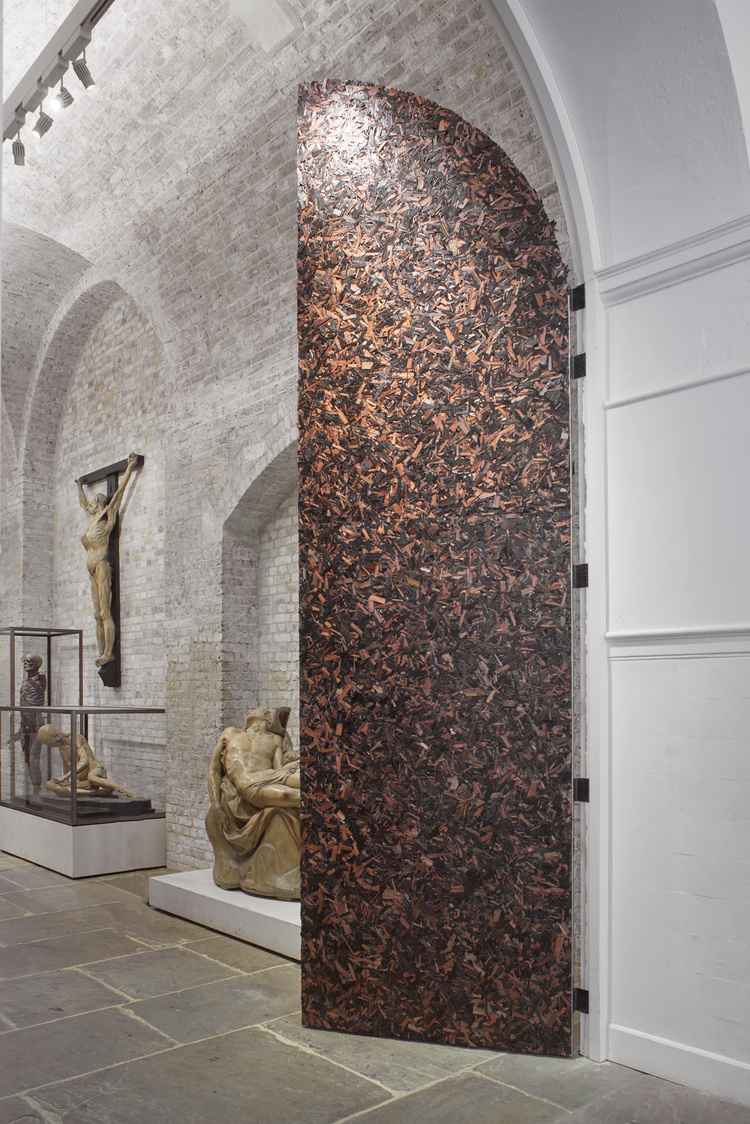

figs.i-ii
This approach was present in work Ogunnaike exhibited for his Royal Academy Schools graduation exhibition. For The Same Way You Came In? (2021) he re-clad a tall internal David Chipperfield designed door with chippings of smoked woods from former colonial nations. Smoked aspen, chestnut, pomelle eucalyptus, oak, and mahogany compressed as textured cladding - “a layering of potential narratives, potential scenes – all of these places smashing together”.
The addition disrupted the space. Deliberately, his intervention only covered one of the two leaves, then left at an angle slightly interrupting the corridor space and Chipperfield’s symmetry, a playful abrasion to the neatness inviting attention and consideration to both artistic act and material.
This play with architecture is central to Ogunnaike’s practice. “It’s a nice way to almost double down or reiterate the idea of successful architectures allowing people to be present” he explains, “if I can have an intervention allowing me to be present in the space without being too contingent on what an artwork is – like traditionally hanging on a wall – it leads to an understanding of how significant architecture can be in informing an individual.”

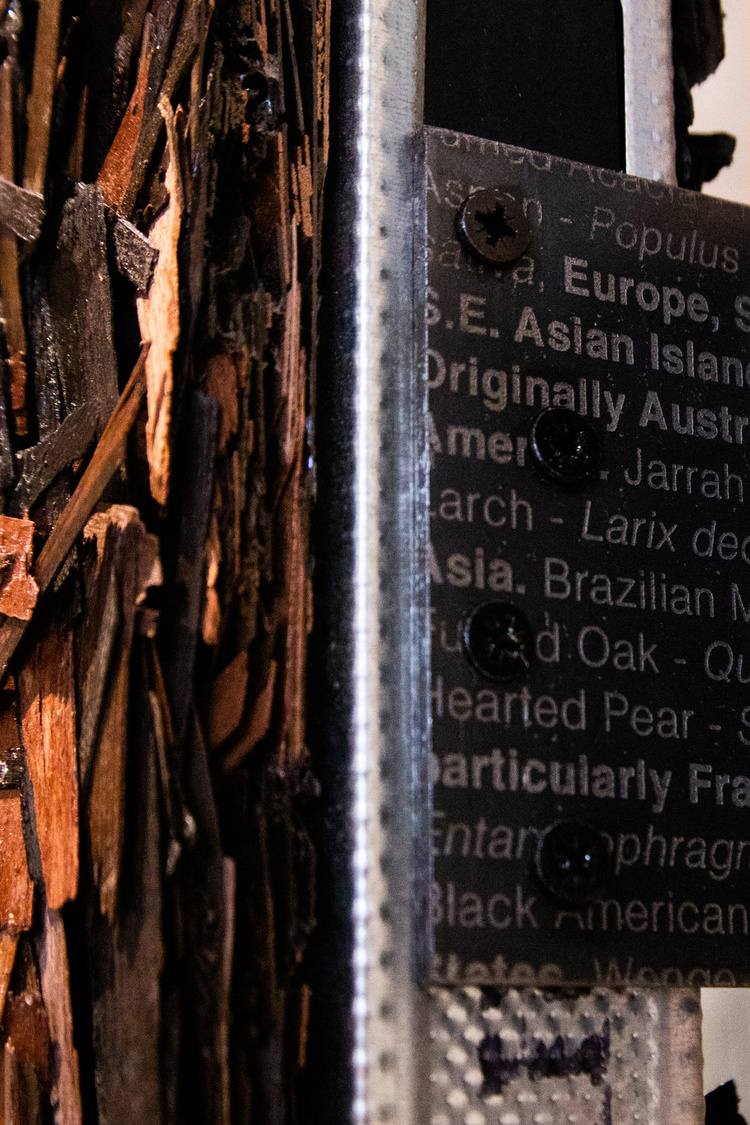
figs.iii-iv
To the artist, architecture is not just the container from which to display his work, it’s a key element of the work itself, and spaces he is invited to exhibit in directly inform what he makes. “There's something about being present in spaces that I pick up - even perhaps on an initial visit there's a way to tap into an understanding of space which is transferable as an idea. There’s a playfulness from an understanding of how we as a society view architecture, then how to make that material in an art context comes from just being present in spaces, as we all are. Instead of being solely reliant on placing an object in space and tweaking the object, why not understand the fabric of the space and use that as an object to be played with.”
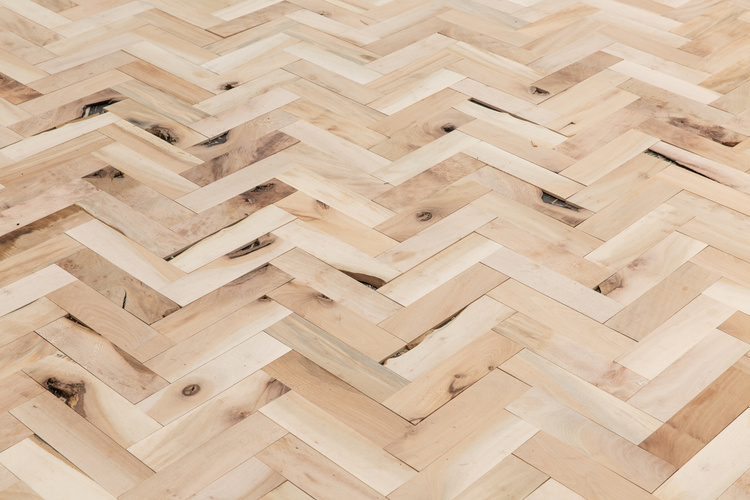

figs.v-vi
The ways in which he plays with spaces and wooden surfaces within are varied. In installation London Plain at Cell Project Space in 2020, he created a herringbone-patterned floor using timber from seven felled London Plane trees which lined High Street Kensington until felled in 2012. A seemingly empty gallery, underfoot the artwork contained not only pollution absorbed from the city but also stories and memories absorbed from those who lived amongst the trees, or from children who played around them – as the artist had when younger:
“London is surprisingly green sometimes, but it's extraordinarily grey. I remember being in the back of my house or on the way to school, and almost daydreaming through trees. Playing conquers or whatever it may be, there are so many associations from the playground to later life that are anchored in the weird botanical foliage-esq.”
London Planes are considered disposable, too ubiquitous to be protected, and when felled are often chipped rather then used as carpentry material. Here they were given a proud second life as both artwork and architectural component. Though, sat on top of the tidy floor Ogunnaike placed two tools – a bronze crowbar and a mallet made from the same London Plane. Over the course of the exhibition the public were free to slowly hammer and peel away at the floor, testing their relationship to architectural space, transfiguring the gallery itself, and slowly revealing a concealed element to the work beneath - a large under-floor text and photographic image slowly emerging.
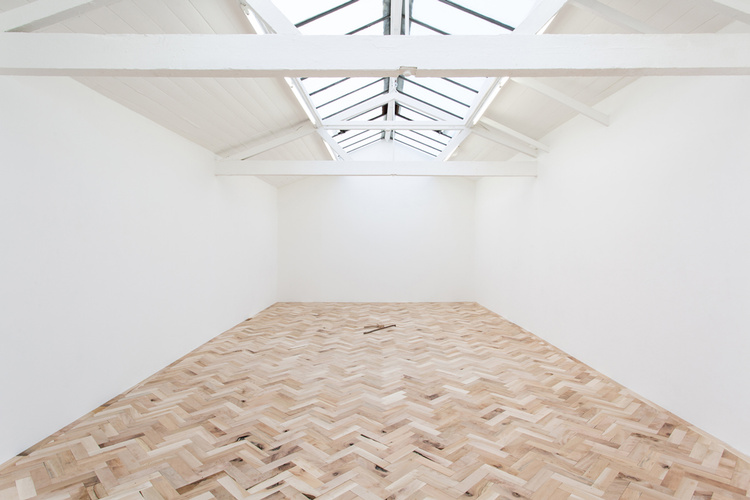
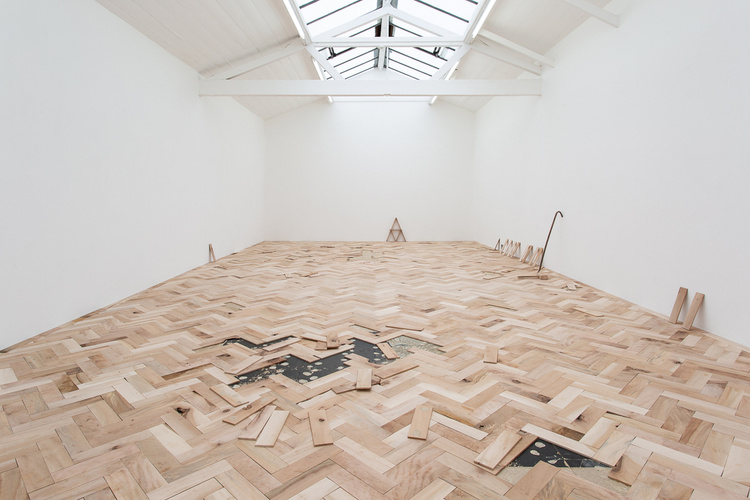

figs.vii-ix
“There was a little poem to how I see London changing – or how we all see London changing constantly. I took a photograph of two trees almost serenading one another under a streetlamp - it was just at the beginning of the first lockdown and I had a drink on my friend’s doorstep. It was just a significant moment when I looked up and said ‘oh we're outside, for once, this is what it used to be like, and I saw these trees cascading over one another - that’s a great photo to remind us of the potential of space and to speak of this unknowing of what we deemed so everyday, and it's fragility.”
Again, a visual play between the symbolic origin of material and its life as functional material, two trees touching across a sun-burst sky as if mimicking Michaelangelo’s Creation of Adam within the Sistine Chapel’s ceiling, a sense of life passed on, continuing again through new material, experience, and form. “ You can take the individual titles and throw them aside, but that tile is still reminiscent of some kind of larger system at play. Regardless of how we disturb it, this thing is still this thing. Underneath the surface, there are the materials, the stories that make these spaces what they are.”

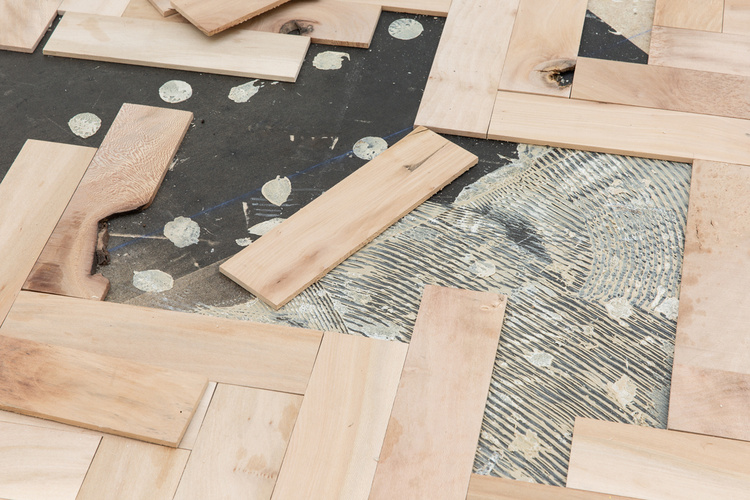

figs.x-xii
For group exhibition Testament at Goldsmiths Centre for Contemporary Art the artist created I’d rather stand (2021), a scaled-down replica of Trafalgar Square’s Fourth Plinth. Having been empty for many years, from 1998 it has been site of changing contemporary art as a platform for sculpture by artists including Antony Gormley, Rachel Whiteread, and Yinka Shinibare.
Ogunnaike’s replica is created from shards of industry-waste wood. Aesthetically, it recalls OSB, the wooden sheets formed of timber shrapnel the artist sees all over the city – on building sites, boarding up windows, at the site of domestic evictions, and all over Notting Hill throughout carnival. It carries, he says, a “sentimental attachment” to the city, though the material in his work is in fact created from waste faux-hardwood, shaved detritus from the manufacture of luxurious veneers to doors, wardrobes, tables, and chairs sold across the globe.


figs.xiii-xiv
His work speaks to the forgotten and everyday – whether London Planes so common to not be noticed until chopped down, or the everyday folk who live in the city – and about seeing, and recognising. I’d rather stand is 6ft 5in, the artist’s height: “There's something about being present which is pretty important, I think. For an individual like myself being present in the arts scene. We see this plinth to successful artists, a monument to people that have made it, but also playfully the title I'd rather stand as opposed to just being represented by the words of others. I’d much prefer to just let this object be a stand-in for me.”
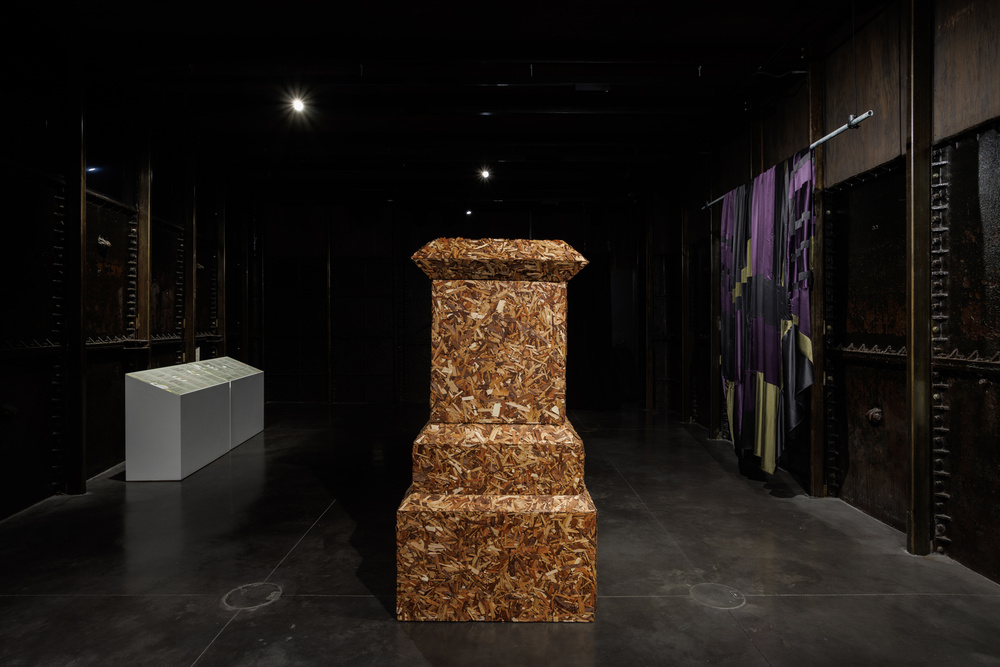
fig.xv
Poetically, Ogunnaike speaks of using “the last material form of this wood – or the death of matter – to depict scenes of life, scenes of togetherness, and to build on the narratives” in his work. It's a poetic gesture, and as with all poetry which abstracts and reforms truths, so Ogunnaike uses dirtied surfaces, redundant waste, and forgotten stories to work towards a new narrative of place, architecture, and people.
For ongoing solo exhibition at CAPC musée d’art contemporain de Bordeaux, the artist considered the rich architecture of the Entrepôt Lainé warehouse, a former wine store of stone walls and timber-beamed roof structure. It has, as all European industries do, a relationship to a colonial past embedded within its fabric, its intended use was as a store of colonial trade, including produce from slave labour.
The artist took sandpaper to the structure, reducing the surface of the beams to dust, an act which at once both sought to cleanse the space of trauma as well as producing a transmuted material from it. The result of that process, symbolically containing stories and collective memories, was left around the gallery space and also used to create images through a screen printing process incorporating wood-dust.


figs.xvi-xvii
The images rendered using the dust were based on photographs of a pre-exhibition meal staff of the museum had enjoyed while seated at one of his artworks, Who’s next, an 8-metre-long pine table spread across the gallery which, after desert, was burnt using the Japanese Shou Sugi Ban method to capture and make durable memories of their collective meal.
“We had a 60 deep staff meal, which was amazing. From cleaners, to security, to the director, it was all the way up - and down. We built a sense of togetherness in this space. During the meal we took photographs of the occasion, and then after the meal I burnt the table and then use that dust to depict some of the images.” Photographs of that meal fixed, using dust from the surrounding architecture and attended table itself. - there are palimpsests of understanding and addition to both the material and memories within Ogunnaike’s art.
“To have this narrative entwined in this building's architecture, and then to remove some and say: ‘OK this history is present, how can our lunch add to this narrative, how can we come from this thing?’ To sand the building, have people present who have a greater history and attachment to it than I could ever have, sat at a table and then using this dust from the building to depict the scenes of this of this lunch. In disturbing it, it almost brought these issues, or these potential issues, to life And then to reactivate them by doing the new prints. it's a nice way to keep this energy going, keep the circle going, as opposed to being stagnant or static.”


figs.xviii-xix
Ogunnaike is not static. With forthcoming exhibitions in Paris and Nice, and possibly in the UK, he is an artist who will keep testing new spaces with old stories, exploring the creative possibilities of wood in all its forms. Perhaps even architecturally one day - at a time of increased timber-frame engineering to fight issues of embedded carbon in the construction industry, might there be architectural collaborations or urban-scale interventions ahead?
“Absolutely. I have fought about in a couple ways. With every new iteration of work, scale is a new variable, which is interesting and nice to kind of think of. I guess with time, we'll have to see…”
Olu Ogunnaike (b.1986) takes trees as repositories of memory within the places and communities in which they grow, Ogunnaike cites wood as a marker of possible encounters: between past and present; between people and the spaces they inhabit. He is interested in the parallels that can be drawn between humans and trees, tracing the moment a tree is uprooted from one geographical setting and placed in another, where it might be transformed. This story – of the composite and accumulative nature of our identities– is inextricably linked to community, labour and the transaction of exchange.
www.oluogunnaike.com
Will Jennings is a London based writer, visual artist, and educator interested in cities, architecture, and culture. He has written for the RIBA Journal, the Journal of Civic Architecture, Quietus, The Wire, the Guardian, and Icon. He teaches history and theory at UCL Bartlett and Greenwich University, and is director of UK cultural charity Hypha Studios.
www.willjennings.info
images
fig.i-iv The Same Way You Came In? (2021), Royal Academy Schools, London. Photographs
© Andy Keate
fig.v-xii London Plane
(2020), Cell Project Space, London. Photographs © Rob Harris
fig.xiii-xv I’d rather stand (2022), Goldsmiths Centre for ContemporaryArt, London.
fig.xvi-xix Crumbs (2021), CAPC musée d’art contemporain de Bordeaux. Photographs © Arthur Pequin
publication date
19 February 2022
tags
Architecture, CAPC musée d'art contemporain de Bordeaux,
Cell Project Space, David Chipperfield, Fourth Plinth, Goldsmiths Centre for Contemporary Art, Colonialism, London, Material, Memory, Olu Ogunnaike, Royal Academy, Royal Academy Schools, Sculpture, Trees, Waste, Wood
fig.v-xii London Plane (2020), Cell Project Space, London. Photographs © Rob Harris
fig.xiii-xv I’d rather stand (2022), Goldsmiths Centre for ContemporaryArt, London.
fig.xvi-xix Crumbs (2021), CAPC musée d’art contemporain de Bordeaux. Photographs © Arthur Pequin
publication date
19 February 2022
tags
Architecture, CAPC musée d'art contemporain de Bordeaux, Cell Project Space, David Chipperfield, Fourth Plinth, Goldsmiths Centre for Contemporary Art, Colonialism, London, Material, Memory, Olu Ogunnaike, Royal Academy, Royal Academy Schools, Sculpture, Trees, Waste, Wood


